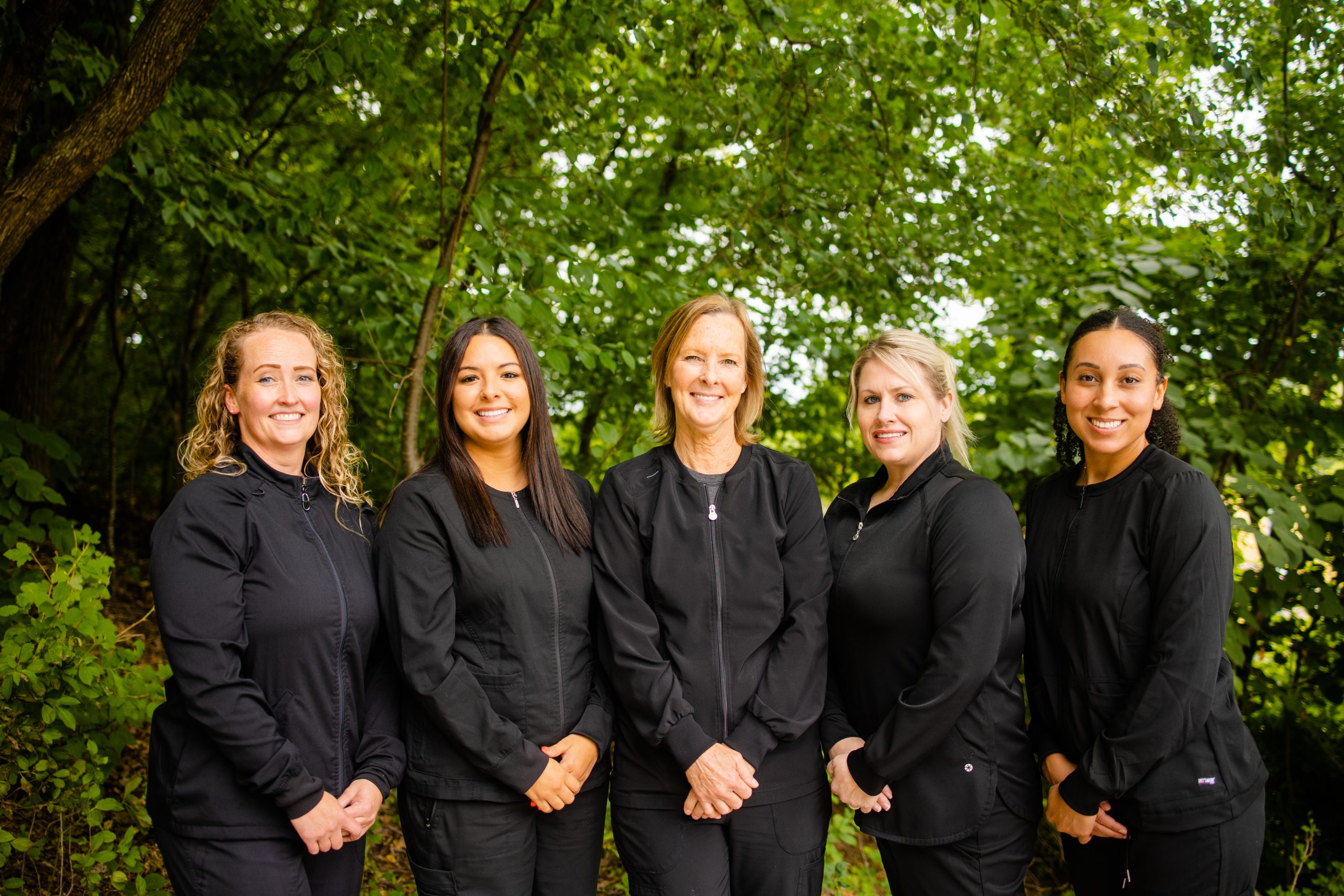Root Canal Therapy - Rochester, MN
How We Save the Most Damaged Teeth
A root canal is a way to preserve your natural tooth if it becomes infected or irreversibly sensitive. It is an alternative to extracting (removing) the tooth so that you can continue to function with your natural teeth. The process involves accessing, cleaning, and then sealing the internal canals that run the length of the roots. After successful root canal treatment, the tooth can function pain and infection free.
Why not Just Take the Tooth Out?
Removing a tooth and leaving a space can lead to shifting of the other teeth. It can also become a slippery slope because every time you remove a tooth, it will put additional stress on the other teeth. In order to preserve the integrity of the bite in functional harmony, it’s best to save and preserve what is naturally in the mouth through root canal treatment when necessary. Root Canal Treatment is an effective way (over 95% success rate!) to keep a tooth in the mouth that would otherwise need to be removed.
Why are People Afraid of Root Canals?
Root canals gained a bad reputation due to ineffective and painful methods used in the past. Comedians, pop-culture, and the Internet have all propagated this stereotype. However, with the advent and improvement of local anesthetics and technology over the years, root canals have become a pain free procedure. You heard right! Root Canal Treatment can and should be a PAIN-FREE experience. Contrary to popular belief, root canals are not only pain free procedures, but also relieve pre-existing pain in the vast majority of cases.
As a dentist, root canal treatment is a great opportunity to not only relieve a patient’s pain but also prove that it can be done pain-free. It is very rewarding to have a patient turn to us afterward and say “I don’t know why I was so worried… that didn’t hurt at all!”
How Long Does a Root Canal Take?
A routine root canal procedure can be finished in as little as one visit of just over an hour. In some cases, if we are unable to completely clean the root canal system, we have to wait to seal the tooth at a separate visit. We want to ensure that our root canals are successful and if there are signs of infection, we do not want to seal those in and potentially lead to failure of the root canal.
How Long Does a Root Canal Treated (RCT) Tooth Last?
As long as an RCT tooth is adequately supported with a dental crown, it should last just as long as any other tooth in the mouth. Posterior (back) molars and premolars are especially susceptible to fracture after having root canal treatment if left unsupported. This is because these teeth generally have more canals than anterior (front) teeth. Dental Crowns are advised to support these teeth after root canal treatment and promote long term success. In some scenarios, RCT can be completed on a front tooth and a simple filling can be placed in the tooth.
Root canal treated teeth have an average survival rate of 95%. This is based on a 5-year survival rate and is dependent on prompt full coverage restoration (in most cases a dental crown).
Contact Gentling Dental Care today for questions on root canals in Rochester, MN or to make an appointment.
Tooth Extractions - Rochester, MN
Expert Care with a Light Touch
Normally, our team’s goal is to repair any teeth that have developed damage or decay, but in certain situations, an extraction might be the only viable treatment. This is usually a last resort after we have exhausted all other options, but when one is necessary, we do everything we can to make sure a patient feels comfortable the entire time. Should you or your child ever require a tooth extraction, you can trust it will be nothing to stress about. If necessary, we can help replace the tooth right away as well.
Why Choose Us for Extractions?
- Patient comfort is priority #1
- Experienced & highly-skilled team
- State-of-the-art tooth replacements available
Why We Might Extract a Tooth
- Extensive Decay: If a cavity is too large to be repaired with a crown or filling, then we will choose to simply remove the tooth.
- Excessive Damage: Most dental restorations require at least a small part of a tooth to be intact, but if a tooth is so damaged that there is nothing to put back together, we’ll extract it.
- Obstructed Adult Teeth: It’s possible for a baby tooth to linger in the mouth and block the path of an incoming adult tooth. We can remove it to make sure the permanent tooth comes in properly.
- More Room: We may remove a few teeth in order to create more room in the mouth so a denture will fit better.
How a Tooth Extraction Actually Works
Fortunately, removing a tooth doesn’t actually involve any pulling . Instead, after thoroughly numbing a patient with a local anesthetic, we simply grip the tooth with a pair of dental forceps, and then we gently rock it back and forth until it slips out on its own. Using this approach, most patients don’t even realize it when their tooth actually comes out!
What to Expect After an Extraction
A little soreness and swelling near the treatment site is normal, but this should go away after a few days. We’ll instruct a patient to take the day of their extraction easy and avoid things like drinking with a straw, rinsing their mouth, or spitting for the first 24 hours, as this could interfere in the formation of a much needed blood clot. A patient should be able to resume their normal diet and activities in about a week or so.
Wisdom Tooth Extractions - Rochester, MN
Safe & Gentle Care for Rochester Families
What makes the wisdom teeth so wise? They actually get their name from the fact that they typically start to come in around the late teens or early twenties, signaling the end of someone’s childhood years. However, they are also the most often extracted teeth. Why? If you have a teenager at home or think you might be experiencing pain because of your wisdom teeth, you’ll find the answers to these questions and more below.
Why Choose Us for Wisdom Tooth Extractions?
- Comprehensive care provided under one roof
- 70+ year history of serving Rochester families
- Compassionate team dedicated to gentle care
What Are the Wisdom Teeth?
The wisdom teeth are actually a third set of molars. For our caveman ancestors, they came in quite handy due to their rough diet, which mostly consisted of roots and tough meats. Over time, cooking methods improved, food became easier to eat, and the human jaw slowly shrank as time went on. Eventually, it got to the point where most people simply don’t have enough room in their mouth for these teeth, which is why they are so often removed.
Wisdom Tooth-Related Problems
When the wisdom teeth start to come in, the usually bring a lot of discomfort with them. They tend to put a lot of pressure on the other teeth, which can cause them to shift, and they often become stuck (or impacted) as well. This can lead to pain in the jaw, and they can sometimes develop an infection as well. Ideally, we’ll be able to keep an eye on a patient’s wisdom teeth so we can remove them before they cause any of these issues.
How a Wisdom Tooth Extraction Works
Most of the time, the wisdom teeth need to be removed before they have fully erupted into the mouth, which calls for a procedure known as a surgical extraction. For this, after thoroughly numbing a patient, we’ll remove any gum or bone tissue that is still encasing the wisdom teeth so we can reach and remove them. Most patients feel next to nothing during this procedure, and while their mouth may be a little sore afterward, the recovery time is usually less than a week.
Meet Your Award-Winning Doctors
A Qualified Team of Dentists Dedicated to Your Smile
At Gentling Dental Care, we strongly believe that five heads are better than one – that’s why our dental office features a team of knowledgeable doctors who all bring unique strengths and skills to the table! At the same time, they share a similar passion for trustworthy, family-friendly dentistry that always adheres to very high clinical standards. To put it simply, they never perform care that they wouldn’t recommend to their very own loved ones.

Dr. Ryan Henrichsen

Dr. Phil Pattee

Dr. Melissa McColloch

Dr. Erich Eichwald

Dr. Scott Gruwell
Read Our Reviews
The Proof is in Our Patients
“Gentling staff graciously fit me into a busy day for a tooth pain emergency. The dentist and assistant quickly found the problem, applied a temporary fix and gave me a treatment plan for follow up. Everyone clearly knew what they were doing. Everyone was friendly and welcoming. All good here!”
- George D.
“I had a wonderful experience during my recent visit. The staff were not only friendly and professional but also genuinely cared about me as both a person and a patient. They consistently take the time to get to know you, your family, and your care needs. Additionally, the services provided were top-notch. Overall, I highly recommend this dental practice to anyone looking for exceptional care.”
- Joe D.
“I had chipped the corner of my front tooth when I was a kid and had a composite filling that time really took a toll on. So, I got an appointment scheduled to get a new filling! Dr. Melissa and Kristie did a wonderful, efficient, and painless job on my tooth. They matched the color and shape perfectly. You can't even tell I have a filling! Thanks for your great work!”
- Meredith M.
“Gentling 's dentists and staff are all very kind, patient, and friendly. Our entire family agreed upon a five star rating for Gentling. We highly recommend Gentling for any family, kids and adults.”
- Todd Z.


See What Makes Us Different
Our Friendly Dental Team Treats Everyone Like Family
1-on-1, Thorough Consultation
Customized Treatment Plan
Every Dental Need Covered
Committed to Continuous Improvement
Our Location
Phone
Address
Working Hours
Monday
8AM - 5PM
Tuesday
7:30AM - 5PM
Wednesday
7:30AM - 5PM
Thursday
7AM - 5PM
Friday
8AM - 12PM

